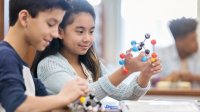Using ELL Strategies in the Science Classroom
How science teachers can use ELL strategies to help students have a better grasp of the vocabulary of science.
Your content has been saved!
Go to My Saved Content.Middle school science students filter into the classroom, gradually transitioning to speaking English as they finish conversations in their first language, Korean or Chinese. One of a series of slides is up on the board, each cuing an activity to get them talking about the subject in the target language, preparing them for the challenge of the vocabulary-dense content area of science.
The volume of science terms discourages many students early on, especially students who don’t often see themselves reflected in the content, particularly girls and students of color. To address the needs of the large language learner population at our school, the two of us—English language learner teacher Kent and science teacher Gina—teamed up to create resources to support students as they grow as both scientists and English speakers.
While these resources were designed with language learners in mind, the activities have proven highly effective in increasing confidence with science vocabulary for native English speakers as well.
Teachers can easily modify each of the resources below to fit different science units or even different content areas and support learners as they transition away from figuring out what to do and instead focus on content, skills, and vocabulary, reducing the amount of time needed for instructions. For example, when students see a vocabulary puzzle in class, they discuss with a partner or small group (in English or their first language) the multiple ways to approach it and then immediately get to work.
Supporting English Language Learners in Science Classes
Interactive student-to-student talk: Using the target language for frequent student vocalizations and student-to-student interactions is a primary goal and the main area we focused on when we developed these resources. Each class starts with an opportunity for students to warm up their science vocabulary, activate schema relevant to the day’s lesson, or retrieve previously learned content, all while practicing their academic interpersonal English skills. We have slides and activities to engage students in partner talk using unit vocabulary, and teachers can easily adapt them for a range of content.
Vocabulary puzzles: Vocabulary puzzles tap visual, kinesthetic, and interpersonal modalities and can be differentiated with little difficulty. Teachers can scaffold the puzzles for different linguistic levels by cutting them into fewer larger pieces before tackling all the pieces separately. Students can also lay pieces on top of the completed puzzle, using it as a key. Once students are confident with the vocabulary, they can use the cards in a dominoes-style game where students make connections between different terms to build an interconnecting board.
Student roles in jigsaw discussions: Dividing up content using a jigsaw strategy gives students the chance to dig in more deeply with a smaller amount of information and offers all learners the opportunity to feel more like an expert about specific content material. This also allows for the leveling of source material to give every student an entry point into the topic. Clear student roles in the discussion ensure that every student is contributing and is engaged during the interactive portion of the jigsaw.
These tools also support effective collaborative talk as students are tasked with asking questions, summarizing main ideas, and using a recording tool to offer a window into their conversations. The teacher can easily change the roles to meet the needs of the students, content, or task.
Fishbowl discussions: Once students feel comfortable with the content vocabulary, it’s important that they get an opportunity to apply it. Fishbowl discussions consist of a small group of students conversing about a unit-related topic while another group of students observes the discussion. Topics are designed to prompt debate, deep thinking, and connections to student experiences, as well as promote the application of unit content and vocabulary.
Tailoring both the student preparation sheet and the observation sheet gives the teacher the opportunity to guide students toward the right content and discussion norms. For example, after noticing that girls were often excluded from discussions involving groups that had a majority of boys, we added an “invites quieter member to share” section to the observations sheet.
The fishbowl format facilitates high-level discussions in the target language and supports students in developing academic and collaborative discussion skills. In classroom reflections, students often point to fishbowl discussions as the activity that really pushes them and helps them learn.
Students thrive in learning spaces where they can be engaged and successful—where they can feel themselves learning. Integrating activities like those above into a science or other content class gives every student entry points for success and the tools to support them in making progress. We encourage teachers to give these strategies a try, measure how classroom interactions shift, and plan their next steps in supporting all learners in communicating about scientific topics.
